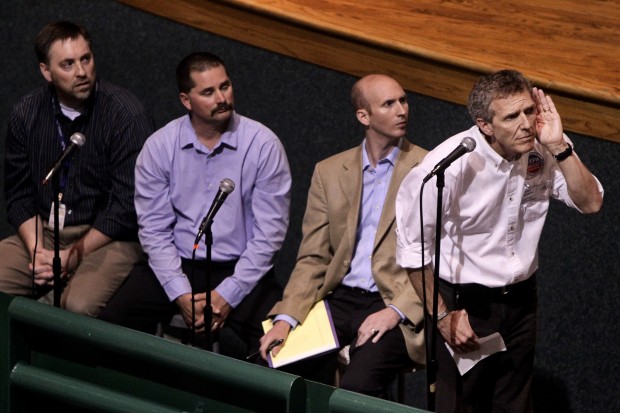Correction: The original version of this story incorrectly stated the West Lake Landfill is the only site in the country contaminated with nuclear waste that is not under control of the Formerly Utilized Sites Remedial Action Program.
Companies have been dumping waste at the West Lake Landfill in Bridgeton since the 1950s. Radioactive materials, created as a byproduct of Mallinckrodt Chemical Works, were dumped in a 200-acre hole there beginning in 1973.
So the fact that there are problems at the landfill shouldnŌĆÖt be a surprise. The Nuclear Regulatory Commission investigated the site and published a report in 1977. The designated it a Superfund site in 1990, making it eligible for special federal funding to clean up the nationŌĆÖs most hazardous waste sites.
People are also reading…
In 2008 ŌĆö 18 years after the Superfund designation ŌĆö the EPA leaped into action. The agency announced plans to cover 40 acres of the site, the part determined to be contaminated with nuclear waste, and to require more control and monitoring. The EPA, the guardians of the nationŌĆÖs environment, had to be pushed by environmental activists and concerned people from the community, into asking the companies that might have been responsible for the problem to come up with alternative cleaning options.
You would think the EPA wouldnŌĆÖt have to be pushed. You would think the people who contaminated the site wouldnŌĆÖt have to be ŌĆ£asked.ŌĆØ You would think they could be ŌĆ£ordered.ŌĆØ You would be wrong.
Two years ago, the EPA again asked those identified as possibly responsible to gather more data and perform more evaluations. Result? Last year, the EPA announced that the radioactive waste remains contained and poses no safety risk to outlying areas. It would have been a surprise if theyŌĆÖd actually admitted there was a problem.
Thirty-seven years after radioactive waste was casually dumped in a landfill, and after 24 years of studies and foot-dragging and buck-passing, enough already. The people whose homes and businesses surround the site need some relief. The EPA isnŌĆÖt getting it done.
Unfortunately, to change that would take an act of the United States Congress, a body that specializes in not getting things done.
The Missouri Coalition for the Environment; the ║³└Ļ╩ėŲĄ County Council; state Sen. Maria Chappelle-Nadal, D-University City; state Rep. Keith English, D-Florissant; and the Pattonville Fire District are among those calling for a shift of responsibility for the site.
Their main goal is to have the radioactive waste removed. If the EPA canŌĆÖt get an agreement to make that happen and to make it happen quickly, they want something called the put in charge.
The awkwardly named FUSRAP is an environmental remediation program under the direction of the U.S. Army Corps of Engineers. While moving responsibility from one federal agency to another might not sound like much help, evidence shows otherwise.
The West Lake Landfill is the only site in the county contaminated with nuclear waste that is not under the control of FUSRAP. The radioactive waste in Bridgeton came from a place that is now a FUSRAP site.
HereŌĆÖs why the Corps of Engineers is a better idea: FUSRAP doesnŌĆÖt have to ask the companies that will pay for a cleanup if a site needs it. If the corps determines that the site needs cleaning, it does it and then negotiates for payment with the parties responsible for the environmental hazard.
Under the EPAŌĆÖs Superfund program, the financially responsible parties are largely in charge of site studies and of the final recommendation. If they disagree with the EPAŌĆÖs remedy or consider the cost unreasonable ŌĆö and not surprisingly, they often do ŌĆö they can sue to keep from cleaning up the site.
Say your neighbor turned his front yard into a dump. A cop could come along and tell him to clean it up. If the cop was from the Corps of Engineers, he could order up a bulldozer and send your neighbor the bill. If the cop was from the EPA, he could say ŌĆ£pretty pleaseŌĆØ and your neighbor could say no, thatŌĆÖs too expensive, and drag things out indefinitely.
Activists and the folks who live near the radioactive waste dump have had it with the EPA. They point out that thereŌĆÖs a fire smoldering in the landfill near the radioactive waste and the EPA doesnŌĆÖt think itŌĆÖs a threat. They criticize the EPA for not consulting with the experts at FUSRAP about the radioactive wastes at the site.
The EPA has been in charge of the West Lake Landfill long enough. The people who live and work and play there deserve better than what theyŌĆÖre getting.
Turning the radioactive West Lake Landfill over to the Corps of Engineers would still not deal with the smoldering fire and stench at the adjacent Bridgeton Landfill. Those are problems for the state to deal with, and Attorney General Chris Koster is trying to do that.
Last month he asked the ║³└Ļ╩ėŲĄ County Circuit Court to order the company managing the Bridgeton Landfill, , to provide additional monitoring data and maps showing the concentration of carbon monoxide at various points across the landfill. He also has a legal order requiring Republic to contain and control the noxious fumes and to address the underground smoldering.
Prodded by Mr. Koster, Republic Services offered temporary relocation assistance to local residents affected by the odors. The problem continues but so do efforts to address it.
As to taking responsibility for the radioactive waste away from the EPA and giving it to the Corps of Engineers, that will involve a change in federal law.
This problem has festered during Democratic and Republication administrations alike. The landfills lie in Democratic Rep. William Lacy ClayŌĆÖs congressional district. Mr. Clay should work with Sens. Roy Blunt and Claire McCaskill and the rest of the areaŌĆÖs congressional delegation to get it fixed as soon as possible. Send the bills later.














